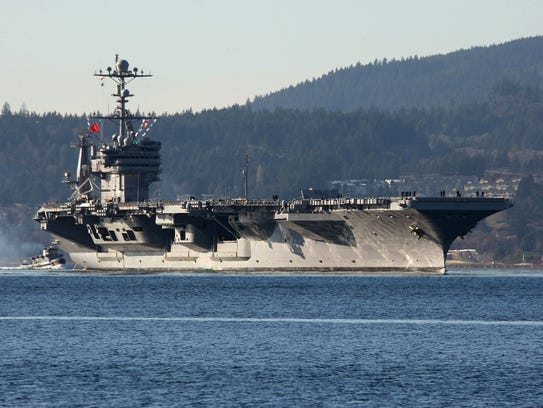Port call refusal could signal more trouble in the South China Sea
Kirk Spitzer, USA TODAY
TOKYO — China’s surprise rejection of a port visit by a U.S. aircraft carrier last week could signal a further escalation of tensions in the disputed South China Sea.
Chinese authorities refused last week to grant permission for the USS John C. Stennis battle group to make a routine port call at Hong Kong. It is the first time in nearly a decade that China has turned away a U.S. carrier.
The move came just two weeks after Defense Secretary Ashton Carter used a high-profile visit to the Stennis to criticize China’s territorial claims and island-building campaign in the South China Sea, a critical waterway that supports $5 trillion a year in international trade.
China has claimed sovereignty over virtually all of the South China Sea and has built a string of landfill islands with military-grade runways and port facilities to bolster its position.
The refusal to host the Stennis battle group was a direct response — and challenge — to Carter’s visit, said Grant Newsham, senior research fellow at the Japan Forum for Strategic Studies in Tokyo.
“From the Chinese perspective, the U.S. has no business in the South China Sea — except perhaps to go through it en route to somewhere else,” said Newsham, a former Marine Corps liaison officer with Japan’s armed forces. “As the Chinese see it, since the U.S. does not follow Chinese rules for operations in this Chinese territory, there is no reason to invite the U.S. Navy to visit Hong Kong.”
Taiwan and four other countries, including the Philippines, a U.S. treaty ally, also claim territory in the South China Sea and have protested China’s actions. The U.S. is concerned that China could use the new islands to interfere with sea and air navigation in the region.
Cmdr. Bill Urban, a Defense Department spokesman in Washington, said Sunday that U.S. officials in Hong Kong were informed by the Chinese government on April 28 that a request for the Stennis and its four escort vessels to visit Hong Kong from May 3-8 was denied. No reason was given.
The flagship of the U.S. 7th Fleet, the USS Blue Ridge, based in Yokosuka, Japan, is currently making a port call in Hong Kong and was not affected.
Urban said U.S. warships have been refused entry to Hong Kong — a frequent port of call for Navy ships for decades — on only two other occasions since China resumed sovereignty in 1997.
“We have a long track record of successful port visits to Hong Kong, including with the current visit of the USS Blue Ridge, and we expect that will continue,” Urban said.
In this photo Dec. 1, 2014 file photo, the aircraft carrier USS John C. Stennis in a file photo Dec. 1, 2014. (Photo: Larry Staegall, AP)
Tensions over the South China Sea are likely to increase in coming weeks.
An international court of arbitration in The Hague is expected to issue a ruling soon on the Philippines’ claims that China is illegally occupying a resource-rich area known as the Scarborough Shoals.
The Philippines considers the region part of its exclusive economic zone. China claims the court has no jurisdiction in the case and has refused to participate in the proceedings.
Although the United States does not officially support individual territorial claims, Carter visited the Stennis while it was cruising not far from the Scarborough Shoals. Lest anyone miss the point, Carter was accompanied by the Philippines’ defense minister on his visit to the nuclear-powered flattop.
Although Carter did not mention China by name during a speech aboard the Stennis, he made it clear the U.S. was unhappy with its behavior in the region.
“In international affairs, disputes should be resolved peacefully, and not by changing the status quo unilaterally,” Carter said. “And we're against that by any of the claimants.”
Since last fall, the U.S. has conducted two “freedom of navigation operations” in waters surrounding islands newly built by China and is likely to conduct a third in the coming weeks.
Alessio Patalano, a lecturer in war studies at Kings College London and a specialist in East Asia maritime security, said the U.S. sent ambiguous messages with the two earlier operations but is likely to get the next one right.
“The U.S. is handling the situation much better now, but of course the key issue is how to prevent the reclamation at Scarborough Shoal,” Patalano said. “Short of parking a couple of destroyers around the area to run an interdiction, there’s little one can do.”
One option would be to rescind an invitation for China's navy to take part in a major multinational naval exercise in waters off Hawaii next month.
Carter told members of Congress in March that he was “reassessing” the invitation for China to attend the exercise, hosted by U.S. Pacific Command every two years. The invitation was extended after China took part in the exercises — for the first time — in 2014, before the current scale of the island-building program in the South China Sea became evident.
“Disinviting (China's navy) would send a clear signal, and a strong one, to both Chinese and (U.S.) partners,” Patalano said. “The Chinese would take it as a serious loss of face, and ... the loss of an opportunity to spy on the U.S. and others.”





